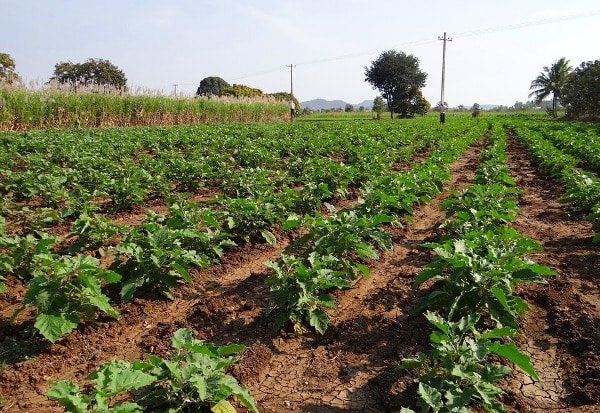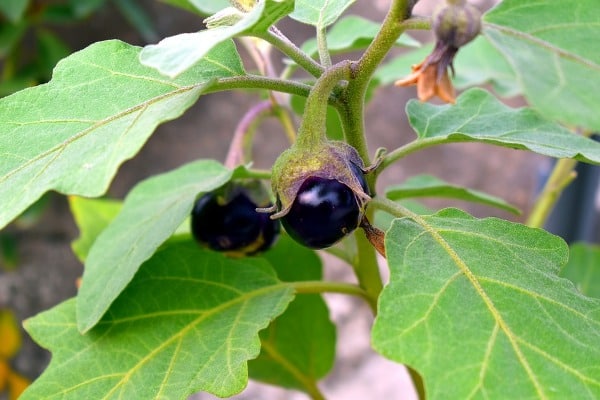Brinjal Pests and Diseases (Eggplant):
Let us discuss today Brinjal Pests and Diseases, symptoms, and their control methods.
Diseases of Brinjal:
Damping-off: This disease causes severe damage to the plants. The main cause of this disease is high soil, moisture, and moderate temperature with high humidity levels during the rainy season.
Pre-emergence damping-off: The pre-emergence damping-off is observed in seed and seedling rot before they emerge from the soil.
Post-emergence damping-off: The post-emergence damping-off will infect the young, juvenile tissues at the ground level. The infected tissues will become soft and water-soaked.
Prevention: Select healthy and high-quality seeds. Treat the seed with Thiram seed before sowing. Soil solarization can be implemented by spreading polythene sheets over the bed for 30 days before sowing is effective to control damping-off to some extent.
Phomopsis Blight:

This is a severe disease in brinjal that infects the foliage and the fruits. The fungus infects the seedlings causing damping off. The infected leaves have small circular spots that appear which turn brown causing blighting. The flesh of infected fruits will rot.
Prevention: Good sanitation, destroying the infected plant material and crop rotation help to reduce the spread of disease. Treat the seeds with Thiram and Spraying organic fungicides with Dithaneor Bordeaux will effectively control the disease.
Leaf spot: The disease symptoms are chlorotic lesions in angular to irregular shapes, later the lesion turns grayish-brown. Infected leaves will drop off leads to reduced yields.
Prevention: Remove and throw away the affected plant and Use organic fungicides with Bavistin or Chlorothalonil for disease control.
Alternaria Leaf Spots: The disease causes leaf spots with concentric rings. The spots are irregular and coalesce and cover large areas of the leaf blade. Severely affected leaves drop off. The infected fruits have large deep-seated spots. The infected fruits turn yellow and drop off prematurely.
Control: Destroy the affected plant parts and spraying the affected plants with Bavistin is useful to control the disease.
Fruit Rot: High humidity is the main cause of this disease. The symptoms of the disease are water-soaked lesions on the fruit, which later enlarges. The fruits infected with the disease will turn brown and develops white cottony growth.
Prevention: Destroy the affected fruits and spraying the crop with organic pesticides with Difolatanwill control the disease effectively.
Verticillium Wilt: This disease will infect young plants and mature plants. The infected young plants show dwarfing and stunting. And infected plants do not flower and fruit. Plants infection after the flowering stage will produce distorted floral buds and fruits, finally results in drop off. The infected leaves have pale-yellow spots and wilting. The roots of the affected plants will split and changes their color.
Control: Crop rotation with okra, tomato, the potato should be avoided.
Bacterial Wilt: Bacterial wilt is a serious disease in brinjal cultivation. The symptoms of this disease are wilting and dropping of leaves. The wilting is gradual, first, the foliage starts yellowing, and then withering and finally drying of the entire plant.
Control: Destroy the affected plant parts and use disease-resistant varieties to prevent disease. Avoid crop rotation with Bhendi, Tomato, Potato. Treated seed with Streptocycline before sowing.
Little Leaf of Brinjal: This is a viral disease of brinjal. This is a disease spread by a leafhopper. The leaves of the infected plants turn light yellow. The size of the infected leaves will shrink. The affected plants are shorter in stature with heavy foliage, roots, and leaves than the healthy plants. The flower parts get deformed, leading the plants to be sterile. Infected plants don’t produce fruits or sometimes produce immature fruits.
Prevention: Good sanitation. Destroy infected plants. Use organic pesticides with Malathion will control diseases and leafhopper.
Mosaic: This is a viral disease transmitted by aphids. The symptoms of the disease are mosaic, mottling on the leaves, and stunting of plants. The leaves of diseased plants are deformed, small, and leathery. Plants show stunted growth.
Control: The disease effect can be reduced by minimizing the population of aphids, removal, and destruction of infected plants, and eradication of susceptible weed hosts. Spraying organic Phosphamidonwill effectively control the aphids in the field.
Read: Frequently Asked Questions About Plant Diseases.

Pests in Brinjal:
Shoot and Fruit Borer: This pest created serious damage to the leaves, flower buds and fruits. The short pinkish larva will be induced into terminal shoots which results in withering and drying of the shoot.
Prevention: Implement crop rotation. Clip of the affected as soon as you find the infected part. Fruits with boring should be removed immediately. Use organic pesticides in a combination of Carbaryl (0.1%) or Cypermethrin (0.5ml/liter of water) after transplanting to control the pest.
Leaf Eating Beetle: The pale yellowish-colored grubs and adult insects that feed on the leaves and tender parts of the plant can cause serious damage to the plant.
Prevention: Destroy the infested leaves along with the grubs, adults, and eggs, which reduced the pest incidence. Use liquid organic insecticides with Malathion or Carbaryl to control the pest.
Jassids: The nymphs and adults will suck the sap of the leaves. The affected leaf will curl upward along the margins and turn to yellow color with burnt-up patches. This insect also transmits little leaf and virus disease like a mosaic. Fruit yields are highly affected by the infestation.
Prevention: Jassids are controlled by spraying liquid organic pesticides with Malathion or Dichlorvos after 15 to 20 days of transplanting.
Leaf Roller: These caterpillars will roll leaves and feed on chlorophyll. The leaves get folded, wither and then dry up.
Prevention: destroying the infested leaves along with insects at the initial stage can minimize the infestation to some extent. Use organic insecticides with carbaryl or Malathion to control the pest effectively.
Red Spider mites: Most common pests of brinjal plants. This is infected due to low humidity levels. Nymphs and adults will suck sap and form white patches on the leaves. The leaves will become mottled, turn brown, and fall.
Control: During high temperatures use organic insecticides with Dicofol and Wettable Sulphur which gives effective control of mites. Removing the severely infested plant parts can reduce the multiplication of mites. Proper irrigation and clean cultivation will keep the pests under control.
Mealy Bug: Nymphs and adults will suck sap from the leaves, tender shoots, and the fruits. The leaves will curl and wither. This pest from heavy black sooty mold may develop on the honeydew-like droplets. Leaves, flower blooms, and fruits are mainly affected by mealy bugs. The affected fruits are entirely covered with the mealybug. And leads to fruit drop or the fruits remain on the shoots in a dried and shriveled condition.
Prevention: Spraying organic insecticides with Dichlorvos Chlorpyriphos and fish oil rosin soap is the best method to control pests.
Lace Wing Bug: This pest mainly attacks in the summer season. Nymphs and dark brown bugs will suck the sap from leaves, and leaves turn yellowish and will be covered with excreting. Affected leaves will dry up.
Prevention: Crop rotation and using organic pesticides with Phosphamidon will help in the reduction of the pests.
Root-Knot Nematodes: this pest will cause severe damage to seedlings than the older plants. The affected plants will develop galls on the roots. The fruits are highly infested and drop off.
Prevention: Crop rotation, rotating the nematode-resistant crop. Treating soil beds with Aldicarb or Carbofuran will increase the seedling growth and reduce the nematode.
Bottom Line: Commercial Brinjal/Eggplant growers must know the most common Brinjal Pests and Diseases affecting the crop.
In case if you are interested in this: Onion Growing Tips, Tricks, and Secretes.
- Economical Aquaculture: A Guide to Low-Budget Fish Farming
- 15 Common Planting Errors That Can Doom Your Fruit Trees
- How to Make Houseplants Bushy: Effective Tips and Ideas
- Innovative Strategies for Boosting Coconut Pollination and Yield
- Pollination Strategies for Maximum Pumpkin Yield
- The Complete Guide to Chicken Fattening: Strategies for Maximum Growth
- Natural Solutions for Tulip Problems: 100% Effective Remedies for Leaf and Bulb-Related Issues
- Revolutionizing Citrus Preservation: Towards a Healthier, Greener Future
- Natural Solutions for Peony Leaf and Flower Problems: 100% Effective Remedies
- Maximizing Profits with Avocado Contract Farming in India: A Comprehensive Guide
- Natural Solutions for Hydrangea Problems: 100% Effective Remedies for Leaf and Flowers
- The Ultimate Guide to Choosing the Perfect Foliage Friend: Bringing Life Indoors
- From Sunlight to Sustainability: 15 Ways to Use Solar Technology in Agriculture
- The Ultimate Guide to Dong Tao Chicken: Exploring from History to Raising
- The Eco-Friendly Makeover: How to Convert Your Unused Swimming Pool into a Fish Pond
- Mastering the Art of Delaware Chicken Farming: Essentials for Healthy Backyard Flocks
- 20 Best Homemade Fertilizers for Money Plant: DIY Recipes and Application Methods
- How to Craft a Comprehensive Free-Range Chicken Farming Business Plan
- Brighten Your Flock: Raising Easter Egger Chickens for Beauty and Bounty
- How to Optimize Your Poultry Egg Farm Business Plan with These Strategies
- Subsidy for Spirulina Cultivation: How Indian Government Schemes Encouraging Spirulina Farmers